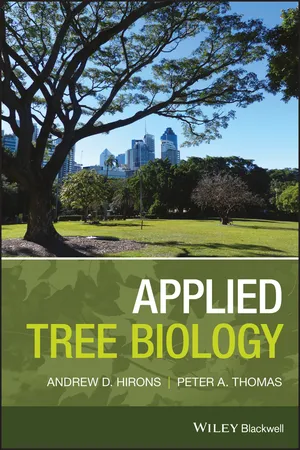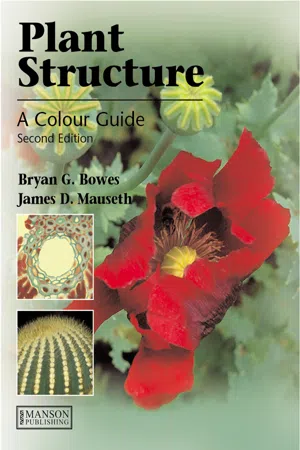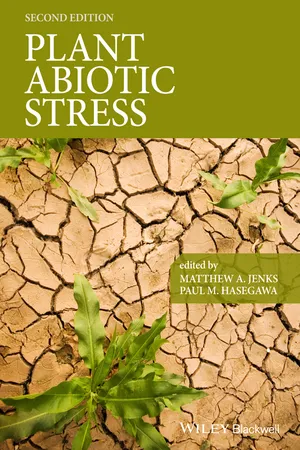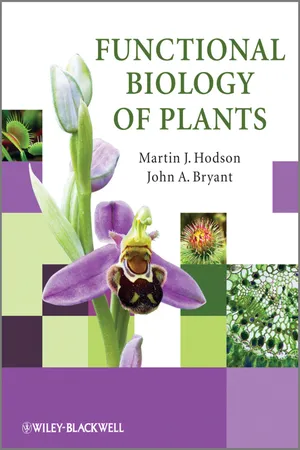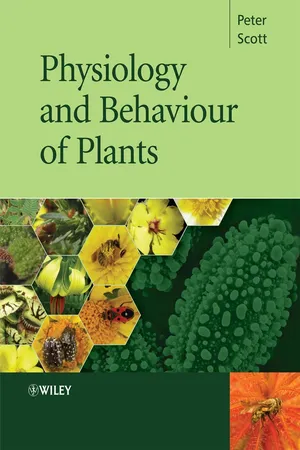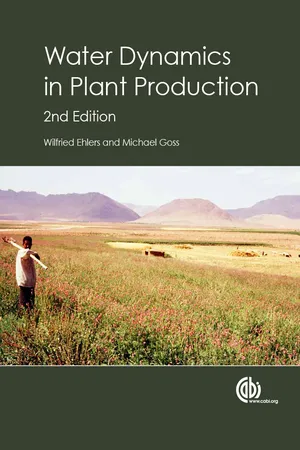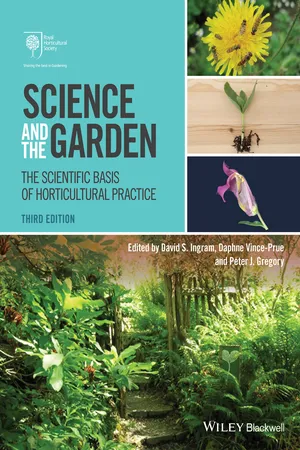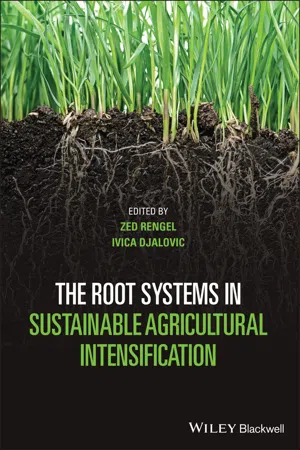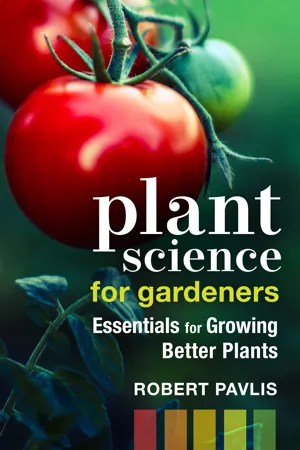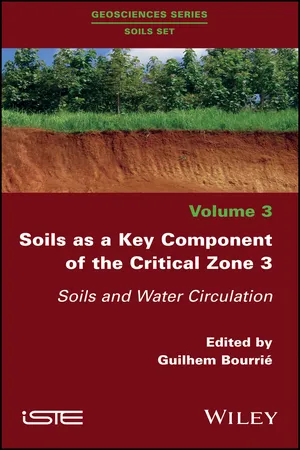Biological Sciences
Plant Root
The plant root is the underground part of a plant that anchors it in the soil and absorbs water and nutrients. It also stores food and provides support for the above-ground parts of the plant. The root system typically consists of the primary root and its branches, which play a crucial role in the plant's growth and development.
Written by Perlego with AI-assistance
Related key terms
11 Key excerpts on "Plant Root"
- eBook - ePub
- Andrew Hirons, Peter A. Thomas(Authors)
- 2017(Publication Date)
- Wiley-Blackwell(Publisher)
4Tree RootsRoots, the ‘hidden branches’ of a tree, are vital for the development and persistence of trees. They are the primary means of water and nutrient uptake, and the tree’s stability is dependent on the roots’ capacity to provide anchorage. Roots grow in response to internal genetic controls but also respond to their environment, allowing them to forage for resource‐rich ‘patches’ within soil. Critically, this interaction between the soil environment and the roots results in highly diverse spatial configurations (architecture), both within and between species. Significant variation exists in the precise anatomy of roots (this can be useful for root identification purposes), but the basic structure of roots is the same; this is briefly described in Box 4.1 .Whilst the uptake of resources and mechanical support are the main functions of roots, they also provide a number of other services. Roots are vital conduits for water, nutrients, carbohydrates and hormones travelling basipetally (from the roots tips toward the shoots), acropetally (from the shoots towards the root tips) and from one portion of the root system to another. Roots act as storage organs for surplus carbohydrates in times of plenty when photosynthetic production of carbon exceeds growth and maintenance requirements. Compounds that help regulate tree development are produced in the roots and transported through the tree to act on the shoots. Roots also produce chemicals that are capable of modifying soil pH and other aspects of the rooting environment, either to their advantage or to the detriment of competitive vegetation. In addition, most root systems also act as a habitat for fungi and a suite of other allied microorganisms within what has been termed the rhizosphere zoo (‘rhiza’ is Greek for root) (Buée et al - eBook - ePub
- Bryan G. Bowes, James D. Mauseth(Authors)
- 2008(Publication Date)
- CRC Press(Publisher)
CHAPTER 7The Root
INTRODUCTION
The basic functions of the root system are the uptake of water and mineral nutrients, anchorage and, sometimes, support (407 –410 ). Roots are also concerned with the supply of cytokinins and gibberellins to the shoot system and commonly store starch. They sometimes are perennating organs (430 ) and may be modified in various other ways such as into contractile roots, pneumatophores (411 , 412), prop roots (413 ), aerial absorptive roots (258 ), haustoria (441 , 442), spines (414 ), and nitrogen-fixing nodules (415 ). Roots also sometimes give rise to adventitious shoots (145 ).In many dicots the radicle of the embryo (46 , 213) develops into the vertically growing taproot from which numerous lateral roots originate (26 , 415). In monocots the radicle is rarely persistent, but instead a fibrous root system develops from the base of the radicle while adventitious roots arise on the lower stem (416 ). The root system of an individual plant may be extensive and it has been calculated that a single mature plant of Secale cereale (rye) may form a fibrous root system up to 40 times greater in surface area than the shoot system. Roots can penetrate several metres deep into the soil.In trees and shrubs the absorptive roots are usually superficially located in the soil but the root system often extends laterally beyond their aerial canopies (407 ). Natural grafting between roots on the same tree (408 , 417) is common, and also frequently occurs between roots on different individuals of the same species. Grafting involves union of cambia and vascular tissue and this provides a possible route of disease transmission from an infected tree to adjacent specimens.ANATOMY OF THE MATURE PRIMARY ROOT
In dicots the core of the root is normally occupied by xylem, with commonly three to five protoxylem poles arranged around the central metaxylem (254 , 418 , 433 , 434). However, roots with two poles (diarch roots) or more numerous poles (polyarch roots) also occur and sometimes a parenchymatous pith-like dilatated metaxylem is present (433 , 434). Monocot root tips are much broader than those of dicots and are polyarch with numerous protoxylem poles (42 , 127); in some palms up to 100 poles occur. A parenchymatous or sclerenchymatous pith-like conjunctive tissue may be present in monocot roots (127 , 257 - eBook - ePub
- Matthew A. Jenks, Paul M. Hasegawa, Matthew A. Jenks, Paul M. Hasegawa(Authors)
- 2013(Publication Date)
- Wiley-Blackwell(Publisher)
4 Root-associated stress response networksJennifer P.C. To1 , Philip N. Benfey1,2 , and Tedd D. Elich11 GrassRoots Biotechnology, Durham, North Carolina2 Department of Biology and Center for Systems Biology, Duke University, Durham, North Carolina4.1 Introduction
The root system is the major point of physical interaction between the plant and its growth substrate. In land plants, roots are required for physical anchorage and for uptake of water and nutrients from the soil. Variable edaphic conditions and weather patterns require that root systems sense and respond to deficiency in water and nutrients, as well as unfavorable conditions such as high content of toxic solutes (Lynch, 1995). Although roots generally do not directly participate in carbon fixation and reproductive processes, they contribute significantly to overall plant fitness and success. Roots must evaluate soil conditions to forage and secure resources for plant growth while excluding and avoiding accumulation of toxic substances (Figure 4.1A ). A significant portion of photosynthetic energy is invested in root growth and establishment in order to secure soil resources. The total fine root surface area of terrestrial plants has been estimated to be matching, if not exceeding, the total photosynthetic leaf surface area across a variety of ecosystems (Jackson et al., 1997). In order to adapt to growth environments, root system architecture exhibits high developmental plasticity and genotype-specific variation (de Dorlodot et al., 2007). Root traits that enhance plant tolerance to abiotic stresses have been termed traits of the second green revolution - eBook - ePub
- Martin J. Hodson, John A. Bryant(Authors)
- 2012(Publication Date)
- Wiley-Blackwell(Publisher)
Chapter 5 RootsIn the previous chapter, we outlined the early development of the embryonic root, the radicle. Now the details of root structure, growth and physiology will be considered, but first the main functions of the root will be summarized. Long distance transport of water, ions and sugars will mostly be considered in Chapter 6, but some aspects will be covered in the present chapter.As one might imagine, knowledge of root structure and function has lagged some way behind that of the shoot. This is particularly the case for root development. The reason is quite obvious, in that it is more difficult to observe roots than shoots. Roots are the main sites for the uptake of water and minerals by most higher plants. There are exceptions, and some plants absorb substantial amounts of water and mineral ions through their leaves, but undoubtedly roots are most important in this respect. Once roots have absorbed water and mineral ions, they are also involved in transporting these up to the shoot. In return, roots receive sugars, the products of photosynthesis, transported from the shoot. These are used in respiration and for building more root tissue.Some roots can become specialized storage organs (e.g. carrots), but all will function like this to some extent. Finally, roots are very important in providing a firm anchorage for the plant in the soil. Again there are exceptions, such as the epiphytes that grow on trees, but the vast majority of plants are rooted in the soil.Box 5.1 : An unusual root laboratorySome years ago, one of us (MJH) gave a seminar at Tel Aviv University. After the seminar Professor Yoav Waisel took me to see his rather special laboratory. It was a two-storey building in the botanical gardens called the ‘Laboratoire central Sarah Racine pour la Recherche sur les Racines’. Yoav explained that a friend of his, Sarah Racine, had agreed to donate some money for research at the Botanic Gardens of Tel Aviv University. It was suggested that her donation could go to help construct a root laboratory to study in situ - eBook - ePub
- Peter Scott(Author)
- 2013(Publication Date)
- Wiley-Interscience(Publisher)
The ability to photosynthesize makes in necessary for plants to be able to exchange large quantities of specific gases with the atmosphere. This ability also necessitates the consequential loss of great volumes so water. For a plant to survive, it needs to be able to replace this water, and this is one of the major roles of the roots. The xylem tissue then distributes this water around the plant to where it is needed. Another major function of the root system is to obtain nutrients from the soil, and this is the topic of the next chapter.References
Brundrett MC and Kendrick WB (1988) The mycorrhizal status, root anatomy, and phenology of plants in a sugar maple forest. Canadian Journal of Botany , 66, 1153–1173.Brundrett MC and Kendrick WB (1990) The roots and mycorrhizae of herbaceous woodland plants. I. Quantitative aspects of morphology. New Phytologist , 114, 457–468.Dittmer HJ (1937) A quantitative study of the roots and root hairs of a winter rye plant (Secale cereale ). American Journal of Botany , 24, 417.Dixon HH and Joly J (1894) On the ascent of sap. Philosophical Transactions of the Royal Society London Series B , 186, 563–576.Marschner H (1995) Mineral Nutrition of Higher Plants , Academic Press, London.Madson C (1996) Trees born of fire and ice, National Wildlife , 34 (6), 28–35.Mitton JB and Grant MC (1996) Genetic variation and the natural history of quaking. BioScience , 46, 25–31.Rougier M and Chaboud A (1985) Mucilages secreted by roots and their biological function. Israel Journal of Botany , 34, 129–146.Russell RS (1977) Plant Root Systems: Their Function and Interaction with the Soil , McGraw-Hill, London.Tyree MT (1997) The cohesion–tension theory of sap ascent: current controversies. Journal of Experimental Botany , 48, 1753–1765.Wherry ET (1972) Box-huckleberry as the oldest living protoplasm, Castanea , 37 - eBook - ePub
- Wilfried Ehlers, Michael Goss(Authors)
- 2016(Publication Date)
- CAB International(Publisher)
6 The Root – the Plant’s Organ for Water Uptake6.1 The Role of the Root in the Plant
Even in the embryo of seeds the root primordium can be identified. During germination either a primary root will develop, as happens in many dicotyledons, or several radicles emerge from the seed. Many species of the grass family (Poaceae) form three to five of these seminal roots. The roots grow into the soil, anchoring the plant and nourishing the growing shoot by providing water and mineral nutrients. Water is transported from soil to root by mass flow, driven by a difference in total water potential between that at the root surface and that in the surrounding soil. Strictly speaking it is the hydraulic gradient that generates the convective flow of water towards the root surface. Those plant nutrients that are dissolved in the soil solution are inevitably drawn to the root with the convective flow of water. Roots may not take up some solutes as quickly as they arrive with the water. Consequently the soil in the vicinity of the roots will become enriched with nutrients such as calcium (Ca) (Goss, 1991 ) and possibly magnesium (Mg) (Jungk, 2002 ).Besides mass flow, nutrients will be transported to the root surface by another mechanism: the process of diffusion. Transport by diffusion is triggered by nutrient uptake into the plant itself, which lowers the nutrient concentration at or near the root surface. Diffusion is the more important transport process for those nutrients like phosphorus (P) and potassium (K), which are present at only small concentrations in the soil solution (Jungk and Claassen, 1989 ). But even with nitrate, diffusion can be the major transport mechanism towards roots (Strebel and Duynisveld, 1989 ).Roots are not only effective in removing those nutrients from soil solution that are in an available form, but it is significant that they are also able to secrete protons, organic acids and chelating agents. Using these materials they can modify the availability of certain nutrients for themselves. These root exudates stimulate the release of ions from soil minerals, and therefore the bioavailability of macronutrients, such as P, and some micronutrients that normally are only sparingly soluble (Jungk, 2002 - eBook - ePub
Science and the Garden
The Scientific Basis of Horticultural Practice
- David S. Ingram, Daphne Vince-Prue, Peter J. Gregory, David S. Ingram, Daphne Vince-Prue, Peter J. Gregory(Authors)
- 2015(Publication Date)
- Wiley-Blackwell(Publisher)
CHAPTER 6 Soils and rootsSummary
This chapter considers the requirements of plants from soils. It goes on to discuss how soils are formed, how to recognise their key features, and the physical, chemical and biological properties of different soil types. Finally, the structure and growth of roots is described, with special emphasis on their role as absorbing organs.Introduction
Why do plants need soil?
Most plants of interest to gardeners are grown in soil of some kind. However, plants can and do grow perfectly well in the absence of soil; examples include floating aquatics and plants raised in nutrient solutions in commercial hydroponic systems. These examples are, however, quite specialised. Submerged aquatics rely on an internal anatomy that allows the rapid movement of oxygen through the plant (see Chapter 8), whereas commercial hydroponic systems rely on sophisticated techniques for the analysis and maintenance of the growing solutions. Soils, in contrast, provide the essential requirements of plants with relatively little attention, provided that they are properly managed. Because the responses of shoots and roots are closely linked (see Chapter 12), gardeners should know something of the root environment so that they can manage it effectively to produce the plants they want.What do plants want from the soil?
Soils supply several of the requirements needed for healthy plant growth, including anchorage for roots to stabilise the plant, water and nutrients for growth, oxygen to allow roots to respire, and a buffer against changes of temperature and pH. The importance of soils for anchorage is readily appreciated after a storm, when trees growing on shallow soils may be blown over.As a general rule, it is rare for roots to occupy more than 5% of the total soil volume, even in the upper 10–15 cm where they are generally most abundant. The volume occupied decreases very rapidly with depth and is often no more than 0.01% at 50 cm. This means that only a small fraction of the soil within the rooting zone is in direct contact with roots. The implication of this for gardeners is that managing soil fertility - eBook - ePub
- Patricia Barnes-Svarney, Thomas E. Svarney(Authors)
- 2014(Publication Date)
- Visible Ink Press(Publisher)
The root cap is a thimblelike mass of parenchyma cells (for more about these cells, see this chapter) that covers and protects the growing root tip as it penetrates the soil. The root cap is pushed forward as the root tip grows longer. The cells on the periphery of the root cap are thrown off as the root cap is pushed forward; new cells are added by the meristem. The root cap also protects the meristem, aids the root as it penetrates the soil, and plays an important role in controlling the response of the root to gravity (called gravitropism, or the response of a plant growth to gravity). From their origin until they are sloughed off, root cap cells live four to nine days, depending on the length of the root cap and the plant species.What are the functions of the root system?
The major functions of roots are: 1) to anchor the plant in the soil; 2) the storage of energy resources, such as the carrot and sugar beet; 3) absorption of water and minerals from the soil; and 4) to conduct water and minerals to and from the shoot. The roots store the food (energy resources) of the plant, which is either used by the roots themselves or digested; the products of digestion are transported back up through the phloem to the above-ground portions of the plant. Plant hormones are synthesized in certain regions of the roots and transported upward in the xylem to the upper parts of the plant, thus stimulating growth and development.How deep and wide does the root system of trees penetrate the soil?
How deep a root system penetrates the soil is dependent on moisture, temperature, composition of the soil, and the specific plant. Most roots actively absorb water and minerals. Although the “feeder roots” of most plants are found in the upper 3 feet (1 meter) of the soil, those of many trees are mainly in the upper 6 inches (15 centimeters) of the soil—the part of the soil richest in organic matter. In general, the lateral spread of a tree’s root system is four to seven times greater than the spread of the crown of the tree.What plants have the deepest root systems?
Plenty of root systems go deep underground—some have made it to record depths. The roots of the Boscia albitrunca (Shepherd’s tree) reach 223.1 feet (68 meters) deep, and the Acacia erioloba (camel thorn) roots extend 196.9 feet (60 meters) into the ground, both in the Kalahari Desert; the Juniperus monosperma (one-seed juniper) roots go up to 200.1 feet (61 meters) deep in the Colorado Plateau; the Eucalyptus spp. in the Australian forests; and the roots of the desert shrub mesquite (Prosopis juliflora - Zed Rengel, Ivica Djalovic, Zed Rengel, Ivica Djalovic(Authors)
- 2021(Publication Date)
- Wiley-Blackwell(Publisher)
In contrast, at the root level, crop management modifies the environment (root zone) to optimize the plant growth factors/conditions. Ecophysiological understanding of processes at the soil–root interface can minimize uncertainties in the translation of the soil management decisions (e.g. fertilization and tillage) into desired plant responses. Based on Körner (2015), who provided evidence that the source (photosynthetic) activity depends on the sink strength (with turgor pressure‐driven cell elongation as a primary signal), the root zone management turns into a fundamental agronomic lever to control shoot growth and yield potential. 3.4.2 Roots for Soil Priming (‘Bio‐tillage’) The exploitation of root systems to create optimum soil structural conditions for crop growth is an obvious target considering the fundamental role of root systems in soil aggregation and porosity. This strategy is known as ‘soil priming’, with plant species defined as ‘primer plants’ (Yunusa and Newton 2003), or biological drilling (Cresswell and Kirkegaard 1995). The disruptive/loosening mechanical forces from tillage implements are much higher than the forces exerted by Plant Roots (e.g. ≈20 N for ploughing vs. ≈0.1 N for a 1‐mm‐diameter root; Kolb et al., 2017 ; Ucgul et al. 2017). However, there is no tillage implement to create elongated and highly connective pores similar to biological agents (e.g. roots and earthworms; Pagliai et al. 2004). There are cases where ‘biological tillage’ via Plant Roots changes soil structure in a way that cannot be attained by the mere utilization of mechanical implements: (i) subsoil resource access, (ii) soil compaction, (iii) no‐tillage agriculture, and (iv) soil erosion control. 3.4.2.1 Access to Subsoil Resources Biological macropores constitute only a small proportion (<1%) of total soil porosity (Gaiser et al. 2013)- eBook - ePub
Plant Science for Gardeners
Essentials for Growing Better Plants
- Robert Pavlis(Author)
- 2022(Publication Date)
- New Society Publishers(Publisher)
Roots are plant structures that typically grow underground to stabilize the plant and obtain resources from the soil. The basic structure of a root consists of the epidermis, root cap, root hairs, cortex and vascular bundle. Root systems are highly productive and can be many times larger than the top growth.Roots are critical to the survival of almost all plants. They anchor plants in place and obtain water and minerals from the soil.Parts of a root.Roots help plants survive winter and other harsh environmental conditions by storing water, nutrients and carbohydrates. They can also contribute to asexual reproduction by producing root suckers or root sprouts which can become independent plants.EpidermisThe epidermis is an outer layer of cells that surround the root. It functions as the skin of the root and allows water and nutrients to travel from the outside to the inside of the root. It also controls the movement of plant-produced chemicals, collectively called “exudates,” to travel out of the root.The epidermis also allows oxygen to move into the root, which is critical for respiration.Cortex and Vascular BundleIn simple terms the inside of a root can be divided into the cortex and the vascular bundle (xylem and phloem). The primary function of the cortex is to conduct molecules between the epidermis and the xylem and phloem. In thicker roots it is also important for storing carbohydrates produced by the leaves. A mature carrot root is mostly a thick cortex full of these carbohydrates.The xylem moves water and nutrients from the soil to all other parts of the plant, while the phloem moves minerals, proteins, sugars and other photosynthates from the upper plant to the roots.Root HairsGardeners talk about roots absorbing water and nutrients but it is actually the root hairs that do most of this. Root hairs look like very fine white hairs coming out of the roots. They tend to be too small to see them in most soil, but they are very visible on newly germinated seedlings.Root hairs are an extension of the root epidermis. Most are formed near the root tips and they only last a couple of weeks. After that, the root aborts them and grows new ones closer to the root tip. A plant’s ability to replace them quickly is important for its survival. For example, if things get too dry, the plant aborts the root hairs, but keeps the roots. When enough moisture returns the plant quickly grows new root hairs to make use of the water. - eBook - ePub
Soils as a Key Component of the Critical Zone 3
Soils and Water Circulation
- Guilhem Bourrié, Guilhem Bourrié(Authors)
- 2018(Publication Date)
- Wiley-ISTE(Publisher)
rhizosheath). The rhizosphere is a place of intense exchanges (water, mineral elements) with, in particular, the exudation of carbon compounds by the Plant Root (such as sugars, amino acids and exopolysaccharides) at the root–soil interface, which can represent up to 30 % of photosynthesis. This carbon input in soil strongly stimulates microbiological activity, which significantly impacts the geochemical conditions in the rhizosphere compared to the bulk soil away from the roots. In relation to water, the biological activity in the rhizosphere may produce organic compounds that alter the properties of the soil water. These may be surfactants, such as phospholipids, which decrease the water surface tension and can reduce the soil water retention or decrease its hydraulic unsaturated conductivity. These can also be exo-polymers, especially exopolysaccharides, which can increase the soil water retention through their strong capacity for water absorption, but also, because they get hydrophobic when dry, can hydraulically disconnect the root from the bulk soil during a drought and delay the re-watering that will follow. Finally, the combination of wetting/drying cycles in the rhizosphere, along with the production of carbon compounds such as exopolymers, can strongly modify the soil structure close to the roots, altering the distribution of pore size and contributing to aggregate formation as well as rhizosheaths. This set of modifications of soil properties, which impacts soil–root water transfers, is currently poorly accounted for due to its variability in space, i.e. along the roots, and in time, i.e. with root growth.3.6. Soil/roots systems biophysical models
Overall, water flow in the soil–plant continuum can be broken down into three successive stages that define the water supply conditions of a plant:3.6.1. Description of water transport mechanisms in soil- 1) initially, the supply phase corresponds to the interception of soil water by the root system. This interception is mediated by water transfers in the soil (water flows in the soil, and from the soil to the roots), but also through the growth of the root system, which makes it possible to colonize soil zones not yet exploited;
- 2) the water then travels from the outer medium (soil) to the inner medium (xylem vessels in the root): this is the absorption phase;
- 3) water is then transported over long distances in the plant, first within the roots, then from the shoot to the leaves: this is the transport phase.
These stages, however, are not independent and a constant interaction exists between the various phenomena governing this absorption (root arrangements, water availability, physiological state of roots, etc.).Gardner [Gar60] was one of the first to formalize on a physical basis this dynamic vision of water transport to the root. In this analysis (known as the microscopic approach, corresponding to a root segment), roots are considered as being infinitely long vertical cylinders (radial flow), taking up water at a constant rate in a soil with very simplified hydraulic properties. More recently, this approach has been extended to various types of boundary conditions, to more realistic hydraulic properties or to a bundle of roots that are identical and distributed in a regular fashion as parallel cylinders in the soil. The latter is equivalent to assuming that all of the roots extract water in an “equivalent cylinder of soil” centered on the root and of radius b equal to (Lυ π)1/2 , where Lυ is the root volume density (cm of root per cm3 of soil). According to these assumptions, a simplified relation (see [FR04]) links the drop in water potential between the soil and the root surface and the water uptake flux, assuming that the water flow is zero at b (the soil external radius exploited by the root) and that the root uptake flux qr
Learn about this page
Index pages curate the most relevant extracts from our library of academic textbooks. They’ve been created using an in-house natural language model (NLM), each adding context and meaning to key research topics.
